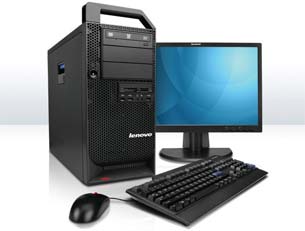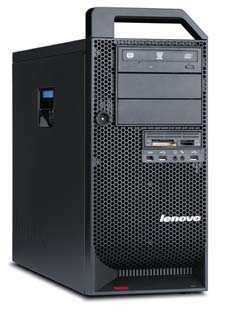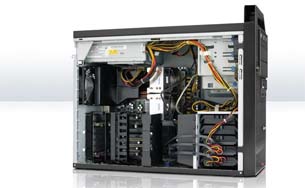ThinkStation D20: Lenovo’s New Dual Quad-Core Powerhouse
This new dual-socket workstation proves to be a heavyweight contender and an optimum choice for running any CAD or analysis application.
Latest News
December 4, 2001
By David Cohn
 The ThinkStation D20 bears a striking resemblance to the S20, housed in a similar black case, but is noticeably larger. It’s powerful, too; perfectly suited for any CAD, DCC, or analysis application. |
For several years now, Lenovo has impressed us with a series of ThinkStation workstations aimed at midrange CAD applications (See November 2009 DE). But those systems were all equipped with single CPUs. Recently, Lenovo sent us its latest powerhouse, the ThinkStation D20, equipped with a pair of Intel X5550 “Gainestown” processors, derived from the “Nehalem” architecture. Like other recent Intel CPUs, the X5500 series provide support for tri-channel DDR3 memory as well as Intel Turbo Boost and Hyper-Threading technology.
The ThinkStation D20 bears a striking resemblance to the S20 we reviewed last year, but is noticeably larger. It comes housed in a similar black case, but this time the case measures 8.25 in. x 23.62 in. x 17 in. (WxDxH), with a removable handle that adds two more inches to its height. As noted in past reviews, we like the handle, which makes it much easier to move the 52-lb. computer. The top portion of the front panel provides three 5.25-in. drive bays, one of which contained a 16X DVD+/-RW dual-layer optical drive. Below these is a smaller bay containing a 20-in-1 media card reader as well as a panel with the power button, two USB ports, and headphone and microphone jacks. Icons above these ports light up, making them easier to find in low-light conditions. There’s also a spot for a FireWire (1394) port, a $29 option that was included on our system.
 A handle adds two inches to its height, but aids in moving the machine around. |
The rear panel provides eight more USB ports as well as a 9-pin serial port, two RJ45 LAN ports, six audio jacks, S/PDIF input and output connections, a second 1394 port, and an eSATA connection. Pressing a small lever on the tool-less chassis is all it takes to remove the side panel to access the well-organized interior.
Inside, the two CPU sockets were fitted with a pair of 2.67GHz Intel X5550 CPUs hidden beneath large heat sinks and cooling fans. Each of these quad-core CPUs has 8MB of smart cache and is rated at 95 watts of thermal design power (TDP). Lenovo offers the ThinkStation D20 with CPUs ranging from the 1.86GHz Xeon E5502 up to the 3.2GHz Xeon W5580. The Lenovo extended ATX form factor motherboard has capability for 12 DIMM sockets. Our evaluation unit came with 8GB installed as four 2GB DDR3 PC3-1060 1333MHz memory modules. The D20 will be able to accommodate up to 192GB of RAM once 16GB DIMMs become available.
The motherboard provides a total of six expansion slots: two PCIe x16 slots, a PCIe x4 slot, a PCIe x1 slot, and a pair of standard PCI adapter card slots. One of the x16 slots on our evaluation unit was filled with an NVIDIA Quadro FX4800 graphics accelerator equipped with 1.5GB of memory. This large, ultra high-end board covered one of the PCI slots and was so wide that we questioned whether it would be possible to install a second FX4800, although Lenovo does offer that option. With two large graphics adapters installed, the only slots left accessible would be the PCIe x1 and one of the PCI card slots. Lenovo also offers less-powerful graphics boards, including the entry-level NVIDIA Quadro NVS290 as well as ATI boards including the Fire Pro V7750.
Lenovo ThinkStation D20 |
The internal drive cage provides five 3.5-in. drive bays with quick-release acoustic-damping rails. Our evaluation unit came equipped with a pair of 500GB Western Digital Caviar 7,200rpm SATA drives configured in a RAID 0 array; they appeared as a single 1TB drive. While that provided lots of storage space and can boost performance, it’s not the safest configuration: if either drive fails all data will be lost. The BIOS also supports RAID 1, RAID 5, and RAID 10 and the motherboard includes five SATA connectors. Other SATA as well as SAS drives are also available.
The 1060W power supply provides more than enough energy and enough additional power connectors to handle any expansion option. In spite of lots of fans, including those on the CPUs, rear panel, power supply, graphics card, and behind the hard drive bay, the ThinkStation D20 was virtually silent after its initial startup.
Cutting edge performance
Lenovo pre-installed the 64-bit version of Windows Vista and also sent us a pair of drives that we could swap out, so we could repeat all of our benchmark tests using Windows XP 64-bit Edition. Once again, Lenovo proved that its engineers know how to combine and configure first-class components to deliver cutting-edge performance. The ThinkStation D20 equipped with the NVIDIA Quadro FX4800 graphics board turned in some of the fastest SPEC viewperf scores we’ve ever recorded on a number of the datasets, with the top SolidWorks dataset numbers coming while running Vista.
When we turned our attention to the SPECapc SolidWorks benchmark, however, which is more of a real-world test (and breaks out graphics, CPU, and I/O performance separately from the overall score), the numbers showed the D20 actually lagging slightly behind the Lenovo ThinkStation S20. While this was initially a bit of a surprise, it’s more the fault of the benchmark test itself rather than the computer. Managing the second CPU adds just enough system overhead to cause this apparent decrease in recorded performance. When you compare the actual scores, the differences between the S20 and D20 as well as the HP Z800 are negligible.
And when we turned our attention to the AutoCAD rendering test, the true performance numbers and the advantage of all those extra CPU cores becomes readily apparent. With hyper-threading enabled, the pair of quad-core CPUs made it appear to the operating system as if the D20 had 16 processors. Since AutoCAD’s Mental Ray rendering engine is multi-threaded, the ThinkStation D20 completed our test rendering in 64 seconds, just 12 seconds behind the HP Z800, whose premium-priced CPUs were running more than 500MHz faster.
 Inside, two CPU sockets were fitted with a pair of 2.67GHz Intel X5550 CPUs hidden beneath heat sinks and cooling fans. Each of these quad-core CPUs has 8MB of smart cache and is rated at 95 watts of TDP. The D20 will accommodate up to 192GB of RAM once 16GB DIMMs are available. |
Lenovo rounded out our evaluation unit with its Preferred Pro USB Fingerprint keyboard, a full-size 104-key keyboard with an integrated fingerprint sensor and accompanying software so you can swipe a finger across the sensor rather than type passwords. A Lenovo-branded Primax optical wheel mouse was also included.
In addition to the 64-bit versions of Windows XP and Vista that we received, you have the option of having other operating systems, including Windows 7 or Red Hat Linux 5 pre-installed, as well as ordering a system with no installed operating system. Several versions of Microsoft Office as well as other application software are also available at the time of purchase. Lenovo backs the system with a three-year limited onsite warranty. The D20 uses 27 percent post-consumer and 23 percent post industrial plastic content, meets Entergy Star 5.0, EPEAT Gold, RoHS, and 80 PLUS Bronze criteria, and is GREENGUARD certified.
Base systems start at $1,269. As configured, our evaluation unit priced out online at $5,943. You could certainly reduce that price significantly by opting for a single hard drive and lesser graphics board, and still end up with an extremely powerful system. Once again, Lenovo has impressed us. The ThinkStation D20 is clearly a top-of-the-line workstation.
More Info
Lenovo
Contributing Editor David Cohn is DE’s MCAD and workstation expert. A computer consultant and technical writer based in Bellingham, WA, he has been benchmarking PCs since 1984. He’s the former editor-in-chief of Engineering Automation Report and CADCAMNet, and the author of more than a dozen books. Please send comments about this article to [email protected]. You can also contact David at [email protected].
Subscribe to our FREE magazine, FREE email newsletters or both!
Latest News
About the Author
David Cohn is a consultant and technical writer based in Bellingham, WA, and has been benchmarking PCs since 1984. He is a Contributing Editor to Digital Engineering, the former senior content manager at 4D Technologies, and the author of more than a dozen books. Email at [email protected] or visit his website at www.dscohn.com.
Follow DE





